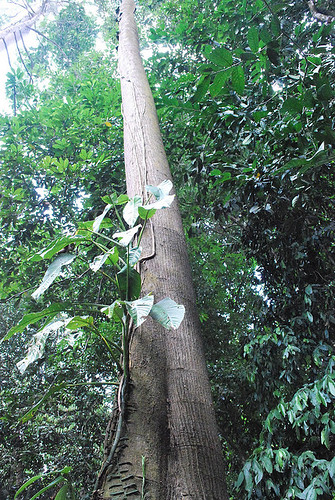Agriculture: friend or foe of the Moluccan cockatoo?
 Tuesday, August 14, 2012 at 23:04
Tuesday, August 14, 2012 at 23:04  Can the cockatoo survive bans on agriculture? Kai BansnerBOGOR, Indonesia. Efforts to prevent agricultural activity inside an Indonesian national park that is a stronghold for the endangered Moluccan cockatoo could backfire, negatively affecting the very species the park was created to protect, ongoing research by CIFOR indicates.
Can the cockatoo survive bans on agriculture? Kai BansnerBOGOR, Indonesia. Efforts to prevent agricultural activity inside an Indonesian national park that is a stronghold for the endangered Moluccan cockatoo could backfire, negatively affecting the very species the park was created to protect, ongoing research by CIFOR indicates.
“Moluccan parrots depend, to some extent, on the human modified forests contained inside the Manusela National Park. So a complete ban on human activity in this park would actually be detrimental to the parrot population,” said Masatoshi Sasaoka, a CIFOR postdoctoral research fellow who has been conducting field work in the park since 2003.
The salmon-crusted cockatoo (Cacatua moluccensis) is endemic to the central Moluccan islands in east Indonesia. The 60,000-strong wild population can still be found on Seram Island, many located in the Manusela National Park. The puffy, salmon-crested cockatoo, a picture of which appears park’s logo, attracts bird watchers from across the globe.
“As we can see … this parrot is conceived as a species with high conservation value which attracts the attention of a great many people,” said Sasaoka while at the 13th Congress of the International Society of Ethnobiology, in Montpellier, in May.
Though ongoing agricultural activities inside the park have been regarded as potential threat to biodiversity and have been banned by Indonesia’s Park Management Authority, the 1,500 mountain villagers that live in the park’s surrounds have long maintained forest gardens, rich in fruiting trees such as durian, jackfruit and water rose apple, and cultivated stands of damar (Agathis damara), used for sustainable resin production for fuel.
 Many parts of Indonesia are dominated by magnificent dipterocarp trees (locally referred to as “damar” trees which is Malay for “resin”). Tian YakeIronically, the Moluccan cockatoos — listed in the most endangered category of animals on earth by the Convention on International Trade in Endangered Species (CITES) — appear to prefer these human-modified areas near communities to remote natural forest, said Masatoshi Sasaoka, who has been conducting field work in the park since 2003 with his collaborators Yves Laumonier and Ken Sugimura.
Many parts of Indonesia are dominated by magnificent dipterocarp trees (locally referred to as “damar” trees which is Malay for “resin”). Tian YakeIronically, the Moluccan cockatoos — listed in the most endangered category of animals on earth by the Convention on International Trade in Endangered Species (CITES) — appear to prefer these human-modified areas near communities to remote natural forest, said Masatoshi Sasaoka, who has been conducting field work in the park since 2003 with his collaborators Yves Laumonier and Ken Sugimura.
“They like to feed on the fruit in the forest gardens, and also nest in the large damar trees grown in human populated areas,” Sasaoka said.
Though his research is still awaiting a comparison of the relative abundance of cockatoos in each forest type, of the 78 cockatoo sites spotted by local villagers, 67 were located in human modified forest gardens. Over a quarter of these were in the park.
His concern is that an exclusion of all agricultural practices inside the park would ultimately be bad for parrot conservation.
“It would be necessary to examine whether it is appropriate to apply conventional ‘zone-based conservation models’ that separate strictly human resource use areas and wildlife habitats,” Sasaoka said ahead of next month’s World Conservation Congress in South Korea, where leading environmental and developmental authorities will discuss ways to protect, manage and govern nature, including the establishment of protected reserves.
This is because, if human modified forests are important habitats of the Moluccan cockatoo, there is a possibility that the current national park management’s measure to strictly exclude any human intervention through agriculture inside the park is inappropriate to promote conservation without damaging local people’s livelihoods, he said.
“It would also be worth considering more flexible conservation models to allow local arboricultural practices with certain conditions inside protected areas.”
He notes “special use zones” have been created within several other national parks — including Gunung Haliumun-Salak National Park in West Java and the Kerinci Seblat National Park in Sumatra — allowing indigenous groups to continue with small-scale agricultural and arboricultural development.
“However those inclusive park management measures were instated because the authorities are trying to consider the land tenure rights of local people to the land and resources, not because the park management authorities acknowledged the conservation value of indigenous agriculture.”
Sasaoka intends to publish his complete findings in 2014.

